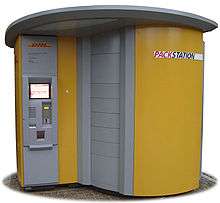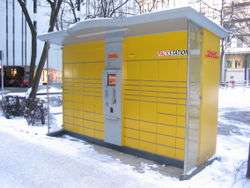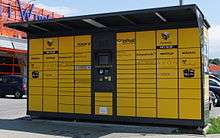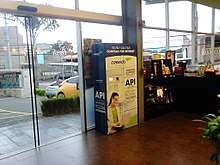Packstation
Packstation is a service run by DHL Parcel Germany, a business unit of Deutsche Post's Mail division, in Germany and elsewhere (e.g. in Italy). It provides automated booths for a self-service collection of parcels and oversize letters as well as self-service dispatch of parcels 24 hours a day, seven days a week. Packstation started as a pilot project in 2001 and was quickly expanded. There are 3,000 Packstation machines in Germany[1] and 90 percent of the people living in Germany were within ten minutes of a DHL Packstation.[2] Only ordinary parcels and letters delivered by Deutsche Post can be delivered to Packstations. Moreover, Deutsche Post allows its subsidiary DHL Express Germany to insert a limited number of express parcels. Packstations were originally manufactured by the Austrian company KEBA with newer stations developed by DHL Paket in conjunction with Polygon.[2]

A major market for Packstation is the increasing number of single people, especially students and time-poor professionals, who purchase products online but are not normally at home at daytime to accept deliveries, or who do not have the time to deposit parcels at the post office during normal opening hours. [3] [4] As of November 2017 there were over 8 million registered Packstation customers in Germany according to Deutsche Post.[5]
Operation
Registration
Using Packstations is free of charge both for private and business customers, however prior registration through the web portal Paket.de [6] is required for collection of parcels.
Each customer obtains a magnetic stripe card ("Goldcard") and PIN that can be used to identify the customer at Packstation machines and post offices. Previously, it was possible to use the Packstation by entering the customer number and the PIN. This was changed in 2011 in order to increase security as said by DHL,[7] usage of the Goldcard is mandatory now. On 29 October 2012, a mandatory mTAN was introduced,[8] this is transmitted solely in the SMS notification or can be retrieved from the DHL Paket App. Each mTAN is valid only for one opening procedure (which may entitle to open several booths if the recipient has received numerous shipments), hereby replacing the PIN.
Delivery and Collection
If a parcel or letter is addressed to a Packstation, it is delivered directly to the specified booth. If the destination is full, the parcel is diverted to the nearest booth with free compartments or to the nearest post office. It is also diverted to the post office if it is too large to fit into the compartments.

As soon as the parcel arrives at the Packstation, the customer is notified by SMS and email. They then have seven business days to collect the package. The customer logs in with their Goldcard and mTAN, and retrieves the parcel.
The Packstation also accepts Maestro debit cards for collect-on-delivery mail.
Customers without Packstation cards
Parcels addressed to a house number (instead of a customer number) are diverted to a Packstation if the recipient is not available to sign for the delivery. In those instances, the recipient receives a green card with a bar code and address of the Packstation. The recipient then goes to the Packstation at his convenience, holds the bar code under the scanner, and follows the simple instructions on the screen. The locker with the parcel then opens automatically and the recipient retrieves the parcel. Delivery in this manner does not require advance registration.
Dispatch
To send a parcel from a Packstation, the customer must first buy a package stamp at a post office, online or directly at a Packstation booth. Return labels from online shops may also be used.
The client scans the bar code on the package stamp after facultatively logging in using the Goldcard. After the parcel size is specified, a compartment opens where the parcel can be placed. The maximum size for parcels is 60 × 35 × 35 cm.
Packstation for businesses
Packstation Inhouse
Since January 2004, DHL has offered in-house Packstations for large businesses (with more than 3000 employees). This service can be used by businesses whose employees receive private parcels at their work address. The first business to set up a Packstation in-house was SAP in Walldorf. Unlike public Packstations, the location of in-house Packstations is not published on the internet. BASF, Siemens, T-Mobile, and T-Online have also set up Packstations on their premises.
Packstation for technicians
Public Packstations are often used by businesses to deliver spare parts to service technicians working in the field, or on the way to the customer.
A few difficulties of using a Packstation
Wheelchair users might have trouble using the Packstations, because some of the compartments are too high for wheelchair access.
The user of a Packstation must agree to give up their right to decline acceptance of delivery when registering for the service. Traditional parcel delivery to a home address or for collection at a post office can be rejected by the customer if visible damage has occurred to the packaging, or if it is an unwanted delivery. However, Packstation customers have the option of filing a complaint with the nearest post office.
Similar systems
.jpeg)


Austria's Österreichische Post introduced a virtually identical service called Post.24-Station in November 2006. The booths are manufactured by the same company that makes the packstations, KEBA. In Vienna, Stations have been erected in supermarkets, petrol stations, and post offices that can easily be reached by public transport.
In the Republic of Ireland, ParcelMotel is owned by the Nightline courier company. ParcelMotel has operated since 2012 and has 124 locations providing over 10,000 locker spaces throughout the Republic of Ireland. ParcelMotel also offers a UK address for parcel delivery which allows customers in Ireland to take advantage of free UK delivery. They also offer free/business paid return services, motel-to-motel delivery at special rates and a parcel sending service.[9]
A company called SmartPOST, run by the Finnish Posti Group runs a network of self-service parcel terminals in Finland and Estonia. The terminals are located in shopping centres and other public premises. They enable clients to send and receive parcels and pay for them at the collection point. There is a terminal for every Estonian in a range of a 15-minute drive. The parcel terminals were introduced to Finland in 2011.[10] The parcel terminals and the software running the system are manufactured in Estonia by Cleveron.[11]
Also, Latvian company, PostService, runs a network of 39 self-service parcel terminals in Latvia, called Mana pasta stacija (English: My Post Station). Terminals are located in 27 cities and towns in Latvia. The terminals are constructed and manufactured in Latvia by PostService itself.[12]
Polish company InPost runs a network of over 6,000 self-service parcel terminals[13] in Poland called Paczkomaty 24/7. Terminals are located in shopping centres car parks and gas stations. The terminals enable clients to send and receive parcels.[14]
Canadian company BufferBox, which was acquired by Google in November 2012, operates a similar system in Ontario. However, the service has since been suspended, and a message on their homepage shows the company is focusing on Google Express Checkout.[15]
Amazon Lockers are a similar service specific to deliveries fulfilled through online retailer Amazon.[16]
Australia Post offers a similar service with facilities located in or near various post offices.[17]
A courier company called Parzel Express introduced automated delivery machines in United Arab Emirates in 2011 manufactured by KEBA.[18]
The United States Postal Service launched a similar service called "gopost" (in lowercase) with the August 2014 installation of 17 lockers in New York City and Washington, D.C.[19]
Correos de Costa Rica offers a similar service with automated delivery machines located in various supermarkets.[20] The test program started in July 2017. The machines are manufactured in Costa Rica.[21] In 2018, the operation of the smart locker system known as API was started. The Api lockers are manufactured by Correos de Costa Rica itself. The network has 102 locations throughout Costa Ríca. With further expansion in the near future. https://correos.go.cr/sucursal-virtual/
References
- "DHL recipient service – Packstation". www.dhl.de. Retrieved 2017-04-04.
- "Deutsche Post DHL Group | May 06, 2014: DHL Packstation – success story continues". www.dpdhl.com. Retrieved 2017-04-04.
- Kirchhoff, Petra (2008-04-17). "Die Packstation kann immer" (in German). Frankfurter Allgemeine.
- Alex Steffen (2008-01-21). "Deutsche Post's Packstation". Worldchanging. Archived from the original on 2008-04-24. Retrieved 2008-04-17.
- "DHL Packstation on course for continued success".
- "DHL Kundenkonto – Ihre Services zum individuellen Paketempfang und -versand | DHL". www.dhl.de.
- "Packstation erhöht Sicherheits-Standards". DHL Packstation Newsletter. DHL. 2011-03-17. Retrieved 2011-05-23.
- http://www.dhl.de/de/paket/privatkunden/packstation/mtan.html
- "Services – Parcel Motel".
- "Posti SmartPost". Archived from the original on 2012-01-16.
- "Cleveron®".
- "PastaStacija.lv". pastastacija.lv.
- "Paczkomaty, Oddziały InPost, Punkty Obsługi Paczek | InPost – Paczkomaty, Kurier, Przesyłki Kurierskie". inpost.pl.
- "Paczkomaty InPost".
- "Google buys locker storage provider BufferBox". SlashGear. December 1, 2012.
- "Amazon Locker main page". Amazon.com.
- "Parcel lockers – Australia Post". Australia post. Retrieved 18 April 2014.
- "Parzel Express and Logistics and KEBA reveal delivery automated solutions with new smart technologies at ID World Abu Dhabi 2012 Summit". AMEinfo.com. 2012-03-22. Archived from the original on 2014-12-09. Retrieved 2014-12-09.
- Whelan, Robbie (18 May 2015). "Parcel-Delivery Firms and Retailers Experiment With Package Pickup Points". Wall Street Journal. Dow Jones & Company, Inc. Retrieved 17 August 2019.
- http://www.apicorreos.go.cr/
- "Costa Rica parcel locker pilot". July 10, 2017.
